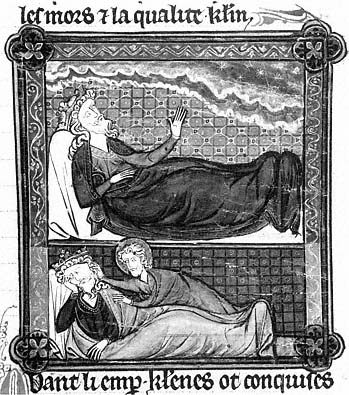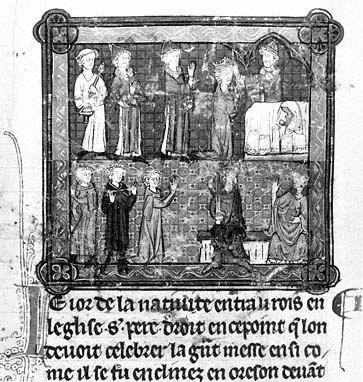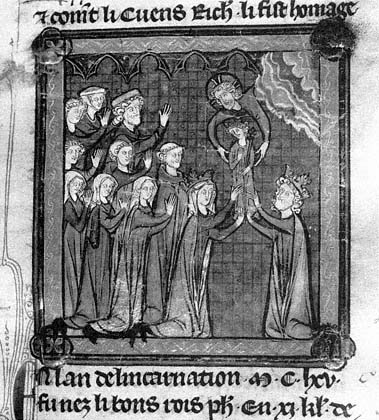Models of Kingship
The Trojan frontispiece and the subcycles of the lives of Charlemagne and Philip Augustus shed light on the ideals of kingship promoted in the Grandes Chroniques given to Philip III. A comparison of the frontispiece with its probable model and of the illustrations of the lives of Charlemagne and Philip Augustus with the subsequent tradition helps to pinpoint consistent aims in the cycle.
As discussed earlier, the frontispiece of the first copy of the Grandes Chroniques emphasizes the Trojan ancestry of the French kings. With certain care-
ful modifications, it copies the most modern visual source for the story to show the ancestors of the French kings as suitable models for kingship.
Pictures illustrating the life of Charlemagne provide similar models. Except for its opening miniature, the subcycle of the life of Charlemagne resembles early cycles of his life based on the Pseudo-Turpin chronicle and is typical of later cycles in the Grandes Chroniques .[37] Nonetheless, the repetition of the figure of Charlemagne in scenes from his life attracts the reader's attention. Thus the dream of Charlemagne encompasses two scenes (Fig. 5): in one the king first sees the vision of the starry road, and in the other Saint James appears to explain it to him. In the miniature of Charlemagne's coronation (Fig. 6) two images invert the relationships between the emperor and the pope. In the upper scene the church is supreme, and Charlemagne kneels to be crowned emperor in Rome at the hands of the pope; in the lower scene the state takes priority, and the pope pleads with Charlemagne to commute the sentences of those condemned by the emperor for degrading the pontiff.
Although these scenes derive directly from the chronicle's text, they depart from it in one important visual detail—they emphasize Charlemagne's kingship

Figure 5
Charlemagne has vision of the starry sky; Saint James
appears to sleeping Charlemagne. Grandes Chroniques
de France . Bibliothèque Sainte-Geneviève, Ms. 782, fol.
141. Photograph: Bibliothèque Sainte-Geneviève, Paris.
rather than his imperial status. Only the miniature of Charlemagne's coronation as emperor includes an imperial crown.[38] Its absence in subsequent miniatures is curious yet may be explained by the historical relationship of the French kings to the empire.
These pictures express a nationalistic tradition that held that Charlemagne was an important model of French kingship.[39] Until the twelfth century Charlemagne was viewed as ancestor of the West Frankish, or French, kings, but not as progenitor of the German rulers who became associated with the Holy Roman Empire.[40] With the exception of the German emperor, Frederick Barbarossa, who sponsored the canonization of Charlemagne in 1165, few Germans felt a popular sentiment for Charlemagne. In France, on the other hand, Charlemagne was immensely popular in both Dionysian and royal circles. As early as the twelfth century, the abbey of Saint-Denis employed numerous devices to tie itself to the growing cult of Charlemagne.[41] A forged charter suggested that Charlemagne had paid homage for France at the abbey. The monks mounted a campaign to promote the oriflamme , guarded at Saint-Denis, as Charlemagne's personal standard. This propaganda was effective and spread into vernacular chansons de geste , like the

Figure 6
Pope Leo III crowns Charlemagne at Rome; Pope and emperor
judge conspirators. Grandes Chroniques de France .
Bibliothèque Sainte-Geneviève, Ms. 782, fol. 121v.
Photograph: Bibliothèque Sainte-Geneviève, Paris.
Pilgrimage of Charlemagne , which celebrated Charlemagne's fictitious trip to the East from which he brought back relics allegedly given later to Saint-Denis by Charles the Bald.
By the reign of Philip Augustus a cult of Charlemagne flourished in France, focusing on Charlemagne as emperor. It was employed primarily to justify territorial expansion.[42] In the popular imagination, reflected in chansons de geste of the twelfth and thirteenth centuries, Charlemagne's empire was equated with the kingdom of France: 170 passages in the chanson de Roland make this equation.[43]
In the late thirteenth century, when this manuscript of the Grandes Chroniques was produced, the association of France with the empire and the French king with the emperor seems to have had a different use. Despite, or perhaps because of, a botched attempt to secure the imperial crown, Philip III placed more emphasis on defining the limits of French kingship than on claiming the empire.[44] Political texts produced during his reign consistently underscore the French king's sovereignty—he is princeps in regno suo who "takes his power from no one except God and himself" (le roy ne tient de nului fors de dieu et de lui )—without any reference to the empire.[45]
The identification of the French king with Charlemagne in a ceremony described in the Grandes Chroniques further strengthened French kingship. Philip was the first king to use Charlemagne's sword, Joyeuse , in the ceremony of coronation, thus emphasizing Charlemagne's role as ancestor of the French kings.[46] Certainly, the portrayal of Charlemagne as a French king in the illustrations of Philip III's Grandes Chroniques was deliberate and, moreover, compatible with his consistent political posture.
Illustrations of the life of Philip Augustus are equally important in this manuscript, both as models of kingship for Philip Augustus's namesake and possibly as a further means of associating Philip III with Charlemagne. The hierarchy of decoration in the manuscript, as well as one particularly powerful miniature, mark this segment of the text with a special subcycle.
A historiated initial of the king enthroned begins the chapter list, and three miniatures illustrate the life of Philip Augustus. Only Philip Augustus's life has a historiated initial mark the chapter list, and miniatures rather than historiated initials illustrate the account of his reign—the first in the manuscript since the histories of the early Carolingians. Doubtless Philip Augustus alone of the Capetians receives such attention in part because he held a special place in the thoughts of Philip III. Philip Augustus was presented along with Saint Louis as a model for Philip III, as, for instance, in the dedication verses to Guillaume de Nangis's Life of Saint Louis .[47] Other writings from the thirteenth and fourteenth centuries describe Philip Augustus as one of the first of a series of holy kings to rule France.
The first miniature of Philip Augustus's life (Fig. 7) suggests this king's holiness and miraculous birth: Christ swoops down from behind a cloud to present a young crowned king to Louis VII and his wife, who kneel in prayer with representatives of a cross section of society. This image is more emblematic than narrative. Instead of illustrating Louis VII's Christological vision (Philip Augustus giving the barons blood to drink from a chalice) or the actual birth of an heir—images that became canonical illustrations for this text in later copies of the Grandes Chroniques —this miniature focuses on Philip's sobriquet, Dieudonné . The picture derives from the text of the chronicle but combines Louis VII's prayer with its

Figure 7
Louis VII and Queen Alix receive Philip Augustus from Christ.
Grandes Chroniques de France . Bibliothèque Sainte-Geneviève,
Ms. 782, fol. 280. Photograph by the author.
response. The text describes how the king, his queen, and all the clergy and people of the realm prayed for the birth of a son. God heard their prayers and gave them Philip, a son whom Louis "nourished healthily and introduced plainly in the faith of Christ and the commandments of the holy church" and whom he had crowned at Reims when he was "of appropriate age."[48]
The portrayal of Philip as a crowned child holding a scepter contradicts part of the narrative; he was not crowned until he was 14 years old. Indeed, Philip's dress alludes to Louis VII's prayer, also recorded in the chapter, in which Louis requests an heir to rule: "Lord, give me a son, heir of my body, noble governor of the realm of France."[49] This boy clad in the attributes of kingship comes in answer to the prayer of the king and the populace for a "governor." The picture thus celebrates both the birth of Philip Augustus and the God-given kingship of France.
In this manuscript Philip Augustus and Charlemagne not only provide Philip III with distinct models for French kingship, but are also associated with
each other. This connection is emphasized by the layout of the cycle of decoration. A reader coming upon the group of miniatures illustrating the life of Philip Augustus might well recall that Charlemagne was the last ruler in this manuscript to have such a cycle.
Textual evidence provides further reasons for associating Philip Augustus with Charlemagne. The most famous text to do so is the reditus regni ad stirpem Karoli Magni , the prophecy that seven generations after the usurpation of the French throne by Hugh Capet, France would be returned to a ruler of Carolingian descent.[50] In this copy of the Grandes Chroniques , discussion of the reditus is limited to a small paragraph at the beginning of Hugh Capet's life which states that Philip Augustus married Elizabeth of Hainaut expressly to recover the line of Charlemagne.[51] In later copies of the chronicle an expanded discussion of the reditus appears at the beginning of the life of Philip Augustus's son, Louis VIII, who fulfilled the prophecy because he was descended from the Carolingians on both his mother's and father's sides.[52] Perhaps because Louis's life was not included in Philip III's manuscript, Philip Augustus is presented as the prime agent of the reditus .
The reditus affected Primat's translation of his sources. In describing the second coronation of Philip Augustus, which took place in Saint-Denis in 1180 during his marriage to Elizabeth of Hainaut, Primat transformed his Latin source, a text by Rigord, by explicitly referring to Charlemagne. The Latin text described how Elizabeth's uncle, Philip of Flanders, carried a sword with honor before the king; Primat's version speaks of "Philip of Flanders, who on this day carried Joyeuse , the sword of the great king Charlemagne, before the king as is right and customary at coronations of kings."[53]
These visual and textual references to Charlemagne and Philip Augustus are provocative because they may echo Philip Augustus's identification with Charlemagne, voiced most explicitly in the reditus . Primat's interpolation, moreover, may have been an attempt to establish a precedent for Philip III's use of Charlemagne's sword in his coronation and to strengthen the identification between Philip III and his great Capetian ancestor Philip Augustus. Mention of the sword Joyeuse was probably intended to recall Charlemagne, Philip Augustus's illustrious predecessor, and to refer to Philip III, his namesake who also used Charlemagne's sword in the ceremony. Thus both text and pictures present Charlemagne and Philip Augustus to Philip III as dual models of kingship.